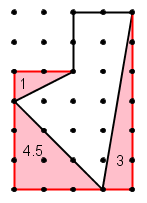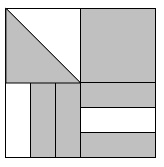Hints will display for most wrong answers; explanations for most right answers. You can attempt a question multiple times; it will only be scored correct if you get it right the first time.
I used the official objectives and sample test to construct these questions, but cannot promise that they accurately reflect what’s on the real test. Some of the sample questions were more convoluted than I could bear to write. See terms of use. See the MTEL Practice Test main page to view questions on a particular topic or to download paper practice tests.
MTEL General Curriculum Mathematics Practice
Question 1 |
A family on vacation drove the first 200 miles in 4 hours and the second 200 miles in 5 hours. Which expression below gives their average speed for the entire trip?
\( \large \dfrac{200+200}{4+5}\) Hint: Average speed is total distance divided by total time. | |
\( \large \left( \dfrac{200}{4}+\dfrac{200}{5} \right)\div 2\) Hint: This seems logical, but the problem is that it weights the first 4 hours and the second 5 hours equally, when each hour should get the same weight in computing the average speed. | |
\( \large \dfrac{200}{4}+\dfrac{200}{5} \) Hint: This would be an average of 90 miles per hour! | |
\( \large \dfrac{400}{4}+\dfrac{400}{5} \) Hint: This would be an average of 180 miles per hour! Even a family of race car drivers probably doesn't have that average speed on a vacation! |
Question 2 |
If two fair coins are flipped, what is the probability that one will come up heads and the other tails?
\( \large \dfrac{1}{4}\) Hint: Think of the coins as a penny and a dime, and list all possibilities. | |
\( \large \dfrac{1}{3} \) Hint: This is a very common misconception. There are three possible outcomes -- both heads, both tails, and one of each -- but they are not equally likely. Think of the coins as a penny and a dime, and list all possibilities. | |
\( \large \dfrac{1}{2}\) Hint: The possibilities are HH, HT, TH, TT, and all are equally likely. Two of the four have one of each coin, so the probability is 2/4=1/2. | |
\( \large \dfrac{3}{4}\) Hint: Think of the coins as a penny and a dime, and list all possibilities. |
Question 3 |
A homeowner is planning to tile the kitchen floor with tiles that measure 6 inches by 8 inches. The kitchen floor is a rectangle that measures 10 ft by 12 ft, and there are no gaps between the tiles. How many tiles does the homeowner need?
30Hint: The floor is 120 sq feet, and the tiles are smaller than 1 sq foot. Also, remember that 1 sq foot is 12 \(\times\) 12=144 sq inches. | |
120Hint: The floor is 120 sq feet, and the tiles are smaller than 1 sq foot. | |
300Hint: Recheck your calculations. | |
360Hint: One way to do this is to note that 6 inches = 1/2 foot and 8 inches = 2/3 foot, so the area of each tile is 1/2 \(\times\) 2/3=1/3 sq foot, or each square foot of floor requires 3 tiles. The area of the floor is 120 square feet. Note that the tiles would fit evenly oriented in either direction, parallel to the walls. |
Question 4 |
The chart below gives percentiles for the number of sit-ups that boys of various ages can do in 60 seconds (source , June 24, 2011)
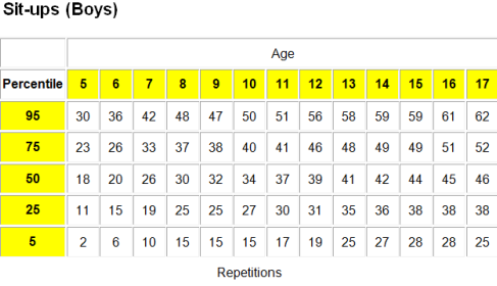
Which of the following statements can be inferred from the above chart?
95% of 12 year old boys can do 56 sit-ups in 60 seconds.Hint: The 95th percentile means that 95% of scores are less than or equal to 56, and 5% are greater than or equal to 56. | |
At most 25% of 7 year old boys can do 19 or more sit-ups in 60 seconds.Hint: The 25th percentile means that 25% of scores are less than or equal to 19, and 75% are greater than or equal to 19. | |
Half of all 13 year old boys can do less than 41 sit-ups in 60 seconds and half can do more than 41 sit-ups in 60 seconds.Hint: Close, but not quite. There's no accounting for boys who can do exactly 41 sit ups. Look at these data: 10, 20, 41, 41, 41, 41, 50, 60, 90. The median is 41, but more than half can do 41 or more. | |
At least 75% of 16 year old boys can only do 51 or fewer sit-ups in 60 seconds.Hint: The "at least" is necessary due to duplicates. Suppose the data were 10, 20, 51, 51. The 75th percentile is 51, but 100% of the boys can only do 51 or fewer situps. |
Question 5 |
| I. \(\large \dfrac{1}{2}+\dfrac{1}{3}\) | II. \( \large .400000\) | III. \(\large\dfrac{1}{5}+\dfrac{1}{5}\) |
| IV. \( \large 40\% \) | V. \( \large 0.25 \) | VI. \(\large\dfrac{14}{35}\) |
Which of the lists below includes all of the above expressions that are equivalent to \( \dfrac{2}{5}\)?
I, III, V, VIHint: I and V are not at all how fractions and decimals work. | |
III, VIHint: These are right, but there are more. | |
II, III, VIHint: These are right, but there are more. | |
II, III, IV, VI |
Question 6 |
Here is a student's work on several multiplication problems:
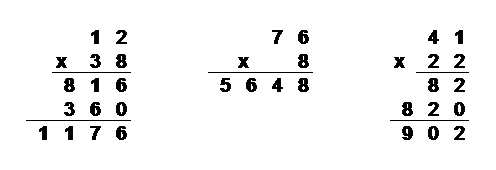 For which of the following problems is this student most likely to get the correct solution, even though he is using an incorrect algorithm?
For which of the following problems is this student most likely to get the correct solution, even though he is using an incorrect algorithm?
58 x 22Hint: This problem involves regrouping, which the student does not do correctly. | |
16 x 24Hint: This problem involves regrouping, which the student does not do correctly. | |
31 x 23Hint: There is no regrouping with this problem. | |
141 x 32Hint: This problem involves regrouping, which the student does not do correctly. |
Question 7 |
The picture below shows identical circles drawn on a piece of paper. The rectangle represents an index card that is blocking your view of \( \dfrac{3}{5}\) of the circles on the paper. How many circles are covered by the rectangle?
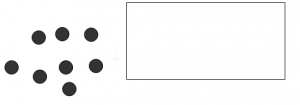
4Hint: The card blocks more than half of the circles, so this number is too small. | |
5Hint: The card blocks more than half of the circles, so this number is too small. | |
8Hint: The card blocks more than half of the circles, so this number is too small. | |
12Hint: 2/5 of the circles or 8 circles are showing. Thus 4 circles represent 1/5 of the circles, and \(4 \times 5=20\) circles represent 5/5 or all the circles. Thus 12 circles are hidden. |
Question 8 |
If x is an integer, which of the following must also be an integer?
\( \large \dfrac{x}{2}\) Hint: If x is odd, then \( \dfrac{x}{2} \) is not an integer, e.g. 3/2 = 1.5. | |
\( \large \dfrac{2}{x}\) Hint: Only an integer if x = -2, -1, 1, or 2. | |
\( \large-x\) Hint: -1 times any integer is still an integer. | |
\(\large\sqrt{x}\) Hint: Usually not an integer, e.g. \( \sqrt{2} \approx 1.414 \). |
Question 9 |
Which of the following is closest to the height of a college student in centimeters?
1.6 cmHint: This is more the height of a Lego toy college student -- less than an inch! | |
16 cmHint: Less than knee high on most college students. | |
160 cmHint: Remember, a meter stick (a little bigger than a yard stick) is 100 cm. Also good to know is that 4 inches is approximately 10 cm. | |
1600 cmHint: This college student might be taller than some campus buildings! |
Question 10 |
Below is a portion of a number line.

Point A is one-quarter of the distance from 0.26 to 0.28. What number is represented by point A?
\( \large0.26\) Hint: Please reread the question. | |
\( \large0.2625\) Hint: This is one-quarter of the distance between 0.26 and 0.27, which is not what the question asked. | |
\( \large0.265\) | |
\( \large0.27\) Hint: Please read the question more carefully. This answer would be correct if Point A were halfway between the tick marks, but it's not. |
Question 11 |
Taxicab fares in Boston (Spring 2012) are $2.60 for the first \(\dfrac{1}{7}\) of a mile or less and $0.40 for each \(\dfrac{1}{7}\) of a mile after that.
Let d represent the distance a passenger travels in miles (with \(d>\dfrac{1}{7}\)). Which of the following expressions represents the total fare?
\( \large \$2.60+\$0.40d\) Hint: It's 40 cents for 1/7 of a mile, not per mile. | |
\( \large \$2.60+\$0.40\dfrac{d}{7}\) Hint: According to this equation, going 7 miles would cost $3; does that make sense? | |
\( \large \$2.20+\$2.80d\) Hint: You can think of the fare as $2.20 to enter the cab, and then $0.40 for each 1/7 of a mile, including the first 1/7 of a mile (or $2.80 per mile).
Alternatively, you pay $2.60 for the first 1/7 of a mile, and then $2.80 per mile for d-1/7 miles. The total is 2.60+2.80(d-1/7) = 2.60+ 2.80d -.40 = 2.20+2.80d. | |
\( \large \$2.60+\$2.80d\) Hint: Don't count the first 1/7 of a mile twice. |
Question 12 |
What is the probability that two randomly selected people were born on the same day of the week? Assume that all days are equally probable.
\( \large \dfrac{1}{7}\) Hint: It doesn't matter what day the first person was born on. The probability that the second person will match is 1/7 (just designate one person the first and the other the second). Another way to look at it is that if you list the sample space of all possible pairs, e.g. (Wed, Sun), there are 49 such pairs, and 7 of them are repeats of the same day, and 7/49=1/7. | |
\( \large \dfrac{1}{14}\) Hint: What would be the sample space here? Ie, how would you list 14 things that you pick one from? | |
\( \large \dfrac{1}{42}\) Hint: If you wrote the seven days of the week on pieces of paper and put the papers in a jar, this would be the probability that the first person picked Sunday and the second picked Monday from the jar -- not the same situation. | |
\( \large \dfrac{1}{49}\) Hint: This is the probability that they are both born on a particular day, e.g. Sunday. |
Question 13 |
Which of the numbers below is the decimal equivalent of \( \dfrac{3}{8}?\)
0.38Hint: If you are just writing the numerator next to the denominator then your technique is way off, but by coincidence your answer is close; try with 2/3 and 0.23 is nowhere near correct. | |
0.125Hint: This is 1/8, not 3/8. | |
0.375 | |
0.83Hint: 3/8 is less than a half, and 0.83 is more than a half, so they can't be equal. |
Question 14 |
In which table below is y a function of x?
 Hint: If x=3, y can have two different values, so it's not a function. | |
 Hint: If x=3, y can have two different values, so it's not a function. | |
 Hint: If x=1, y can have different values, so it's not a function. | |
 Hint: Each value of x always corresponds to the same value of y. |
Question 15 |
In the triangle below, \(\overline{AC}\cong \overline{AD}\cong \overline{DE}\) and \(m\angle CAD=100{}^\circ \). What is \(m\angle DAE\)?

\( \large 20{}^\circ \) Hint: Angles ACD and ADC are congruent since they are base angles of an isosceles triangle. Since the angles of a triangle sum to 180, they sum to 80, and they are 40 deg each. Thus angle ADE is 140 deg, since it makes a straight line with angle ADC. Angles DAE and DEA are base angles of an isosceles triangle and thus congruent-- they sum to 40 deg, so are 20 deg each. | |
\( \large 25{}^\circ \) Hint: If two sides of a triangle are congruent, then it's isosceles, and the base angles of an isosceles triangle are equal. | |
\( \large 30{}^\circ \) Hint: If two sides of a triangle are congruent, then it's isosceles, and the base angles of an isosceles triangle are equal. | |
\( \large 40{}^\circ \) Hint: Make sure you're calculating the correct angle. |
Question 16 |
The picture below represents a board with pegs on it, where the closest distance between two pegs is 1 cm. What is the area of the pentagon shown?
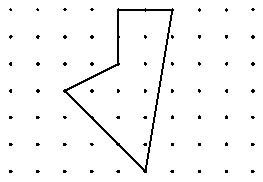
Question 17 |
Use the expression below to answer the question that follows:
\( \large \dfrac{\left( 7,154 \right)\times \left( 896 \right)}{216}\)
Which of the following is the best estimate of the expression above?
2,000Hint: The answer is bigger than 7,000. | |
20,000Hint: Estimate 896/216 first. | |
3,000Hint: The answer is bigger than 7,000. | |
30,000Hint: \( \dfrac{896}{216} \approx 4\) and \(7154 \times 4\) is over 28,000, so this answer is closest. |
Question 18 |
A solution requires 4 ml of saline for every 7 ml of medicine. How much saline would be required for 50 ml of medicine?
\( \large 28 \dfrac{4}{7}\) ml Hint: 49 ml of medicine requires 28 ml of saline. The extra ml of saline requires 4 ml saline/ 7 ml medicine = 4/7 ml saline per 1 ml medicine. | |
\( \large 28 \dfrac{1}{4}\) ml Hint: 49 ml of medicine requires 28 ml of saline. How much saline does the extra ml require? | |
\( \large 28 \dfrac{1}{7}\) ml Hint: 49 ml of medicine requires 28 ml of saline. How much saline does the extra ml require? | |
\( \large 87.5\) ml Hint: 49 ml of medicine requires 28 ml of saline. How much saline does the extra ml require? |
Question 19 |
Here is a mental math strategy for computing 26 x 16:
Step 1: 100 x 16 = 1600
Step 2: 25 x 16 = 1600 ÷· 4 = 400
Step 3: 26 x 16 = 400 + 16 = 416
Which property best justifies Step 3 in this strategy?
Commutative Property.Hint: For addition, the commutative property is \(a+b=b+a\) and for multiplication it's \( a \times b = b \times a\). | |
Associative Property.Hint: For addition, the associative property is \((a+b)+c=a+(b+c)\) and for multiplication it's \((a \times b) \times c=a \times (b \times c)\) | |
Identity Property.Hint: 0 is the additive identity, because \( a+0=a\) and 1 is the multiplicative identity because \(a \times 1=a\). The phrase "identity property" is not standard. | |
Distributive Property.Hint: \( (25+1) \times 16 = 25 \times 16 + 1 \times 16 \). This is an example of the distributive property of multiplication over addition. |
Question 20 |
M is a multiple of 26. Which of the following cannot be true?
M is odd.Hint: All multiples of 26 are also multiples of 2, so they must be even. | |
M is a multiple of 3.Hint: 3 x 26 is a multiple of both 3 and 26. | |
M is 26.Hint: 1 x 26 is a multiple of 26. | |
M is 0.Hint: 0 x 26 is a multiple of 26. |
Question 21 |
Which of the lines depicted below is a graph of \( \large y=2x-5\)?
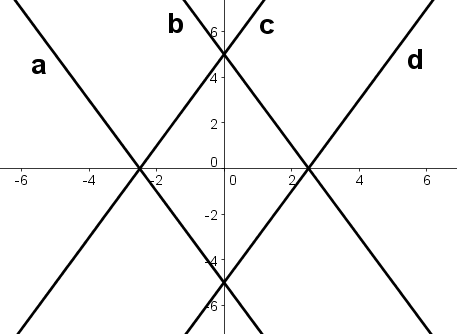
aHint: The slope of line a is negative. | |
bHint: Wrong slope and wrong intercept. | |
cHint: The intercept of line c is positive. | |
dHint: Slope is 2 -- for every increase of 1 in x, y increases by 2. Intercept is -5 -- the point (0,-5) is on the line. |
Question 22 |
Use the problem below to answer the question that follows:
T shirts are on sale for 20% off. Tasha paid $8.73 for a shirt. What is the regular price of the shirt? There is no tax on clothing purchases under $175.
Let p represent the regular price of these t-shirt. Which of the following equations is correct?
\( \large 0.8p=\$8.73\) Hint: 80% of the regular price = $8.73. | |
\( \large \$8.73+0.2*\$8.73=p\) Hint: The 20% off was off of the ORIGINAL price, not off the $8.73 (a lot of people make this mistake). Plus this is the same equation as in choice c. | |
\( \large 1.2*\$8.73=p\) Hint: The 20% off was off of the ORIGINAL price, not off the $8.73 (a lot of people make this mistake). Plus this is the same equation as in choice b. | |
\( \large p-0.2*\$8.73=p\) Hint: Subtract p from both sides of this equation, and you have -.2 x 8.73 =0. |
Question 23 |
Below is a portion of a number line:

Point B is halfway between two tick marks. What number is represented by Point B?
\( \large 0.645\) Hint: That point is marked on the line, to the right. | |
\( \large 0.6421\) Hint: That point is to the left of point B. | |
\( \large 0.6422\) Hint: That point is to the left of point B. | |
\( \large 0.6425\) |
Question 24 |
A publisher prints a series of books with covers made of identical material and using the same thickness of paper for each page. The covers of the book together are 0.4 cm thick, and 125 pieces of the paper used together are 1 cm thick.
The publisher uses a linear function to determine the total thickness, T(n) of a book made with n sheets of paper. What are the slope and intercept of T(n)?
Intercept = 0.4 cm, Slope = 125 cm/pageHint: This would mean that each page of the book was 125 cm thick. | |
Intercept =0.4 cm, Slope = \(\dfrac{1}{125}\)cm/pageHint: The intercept is how thick the book would be with no pages in it. The slope is how much 1 extra page adds to the thickness of the book. | |
Intercept = 125 cm, Slope = 0.4 cmHint: This would mean that with no pages in the book, it would be 125 cm thick. | |
Intercept = \(\dfrac{1}{125}\)cm, Slope = 0.4 pages/cmHint: This would mean that each new page of the book made it 0.4 cm thicker. |
Question 25 |
Which of the numbers below is not equivalent to 4%?
\( \large \dfrac{1}{25}\) Hint: 1/25=4/100, so this is equal to 4% (be sure you read the question correctly). | |
\( \large \dfrac{4}{100}\) Hint: 4/100=4% (be sure you read the question correctly). | |
\( \large 0.4\) Hint: 0.4=40% so this is not equal to 4% | |
\( \large 0.04\) Hint: 0.04=4/100, so this is equal to 4% (be sure you read the question correctly). |
Question 26 |
Use the expression below to answer the question that follows.
\(\large \dfrac{\left( 155 \right)\times \left( 6,124 \right)}{977}\)
Which of the following is the best estimate of the expression above?
100Hint: 6124/977 is approximately 6. | |
200Hint: 6124/977 is approximately 6. | |
1,000Hint: 6124/977 is approximately 6. 155 is approximately 150, and \( 6 \times 150 = 3 \times 300 = 900\), so this answer is closest. | |
2,000Hint: 6124/977 is approximately 6. |
Question 27 |
Which of the following nets will not fold into a cube?
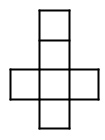 Hint: If you have trouble visualizing, cut them out and fold (during the test, you can tear paper to approximate). | |
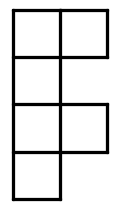 | |
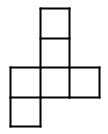 Hint: If you have trouble visualizing, cut them out and fold (during the test, you can tear paper to approximate). | |
 Hint: If you have trouble visualizing, cut them out and fold (during the test, you can tear paper to approximate). |
Question 28 |
Which of the following is equal to eleven billion four hundred thousand?
\( \large 11,400,000\) Hint: That's eleven million four hundred thousand. | |
\(\large11,000,400,000\) | |
\( \large11,000,000,400,000\) Hint: That's eleven trillion four hundred thousand (although with British conventions; this answer is correct, but in the US, it isn't). | |
\( \large 11,400,000,000\) Hint: That's eleven billion four hundred million |
Question 29 |
An above-ground swimming pool is in the shape of a regular hexagonal prism, is one meter high, and holds 65 cubic meters of water. A second pool has a base that is also a regular hexagon, but with sides twice as long as the sides in the first pool. This second pool is also one meter high. How much water will the second pool hold?
\( \large 65\text{ }{{\text{m}}^{3}}\) Hint: A bigger pool would hold more water. | |
\( \large 65\cdot 2\text{ }{{\text{m}}^{3}}\) Hint: Try a simpler example, say doubling the sides of the base of a 1 x 1 x 1 cube. | |
\( \large 65\cdot 4\text{ }{{\text{m}}^{3}}\) Hint: If we think of the pool as filled with 1 x 1 x 1 cubes (and some fractions of cubes), then scaling to the larger pool changes each 1 x 1 x 1 cube to a 2 x 2 x 1 prism, or multiplies volume by 4. | |
\( \large 65\cdot 8\text{ }{{\text{m}}^{3}}\) Hint: Try a simpler example, say doubling the sides of the base of a 1 x 1 x 1 cube. |
Question 30 |
Four children randomly line up, single file. What is the probability that they are in height order, with the shortest child in front? All of the children are different heights.
\( \large \dfrac{1}{4}\) Hint: Try a simpler question with 3 children -- call them big, medium, and small -- and list all the ways they could line up. Then see how to extend your logic to the problem with 4 children. | |
\( \large \dfrac{1}{256}
\) Hint: Try a simpler question with 3 children -- call them big, medium, and small -- and list all the ways they could line up. Then see how to extend your logic to the problem with 4 children. | |
\( \large \dfrac{1}{16}\) Hint: Try a simpler question with 3 children -- call them big, medium, and small -- and list all the ways they could line up. Then see how to extend your logic to the problem with 4 children. | |
\( \large \dfrac{1}{24}\) Hint: The number of ways for the children to line up is \(4!=4 \times 3 \times 2 \times 1 =24\) -- there are 4 choices for who is first in line, then 3 for who is second, etc. Only one of these lines has the children in the order specified. |
Question 31 |
Which of the following is the equation of a linear function?
\( \large y={{x}^{2}}+2x+7\) Hint: This is a quadratic function. | |
\( \large y={{2}^{x}}\) Hint: This is an exponential function. | |
\( \large y=\dfrac{15}{x}\) Hint: This is an inverse function. | |
\( \large y=x+(x+4)\) Hint: This is a linear function, y=2x+4, it's graph is a straight line with slope 2 and y-intercept 4. |
Question 32 |
Solve for x: \(\large 4-\dfrac{2}{3}x=2x\)
\( \large x=3\) Hint: Try plugging x=3 into the equation. | |
\( \large x=-3\) Hint: Left side is positive, right side is negative when you plug this in for x. | |
\( \large x=\dfrac{3}{2}\) Hint: One way to solve: \(4=\dfrac{2}{3}x+2x\) \(=\dfrac{8}{3}x\).\(x=\dfrac{3 \times 4}{8}=\dfrac{3}{2}\). Another way is to just plug x=3/2 into the equation and see that each side equals 3 -- on a multiple choice test, you almost never have to actually solve for x. | |
\( \large x=-\dfrac{3}{2}\) Hint: Left side is positive, right side is negative when you plug this in for x. |
Question 33 |
Use the four figures below to answer the question that follows:

How many of the figures pictured above have at least one line of reflective symmetry?
\( \large 1\) | |
\( \large 2\) Hint: The ellipse has 2 lines of reflective symmetry (horizontal and vertical, through the center) and the triangle has 3. The other two figures have rotational symmetry, but not reflective symmetry. | |
\( \large 3\) | |
\( \large 4\) Hint: All four have rotational symmetry, but not reflective symmetry. |
Question 34 |
The prime factorization of n can be written as n=pqr, where p, q, and r are distinct prime numbers. How many factors does n have, including 1 and itself?
\( \large3\) Hint: 1, p, q, r, and pqr are already 5, so this isn't enough. You might try plugging in p=2, q=3, and r=5 to help with this problem. | |
\( \large5\) Hint: Don't forget pq, etc. You might try plugging in p=2, q=3, and r=5 to help with this problem. | |
\( \large6\) Hint: You might try plugging in p=2, q=3, and r=5 to help with this problem. | |
\( \large8\) Hint: 1, p, q, r, pq, pr, qr, pqr. |
Question 35 |
Which of the following is equal to one million three hundred thousand?
\(\large1.3\times {{10}^{6}}\)
| |
\(\large1.3\times {{10}^{9}}\)
Hint: That's one billion three hundred million. | |
\(\large1.03\times {{10}^{6}}\)
Hint: That's one million thirty thousand. | |
\(\large1.03\times {{10}^{9}}\) Hint: That's one billion thirty million |
Question 36 |
The least common multiple of 60 and N is 1260. Which of the following could be the prime factorization of N?
\( \large2\cdot 5\cdot 7\) Hint: 1260 is divisible by 9 and 60 is not, so N must be divisible by 9 for 1260 to be the LCM. | |
\( \large{{2}^{3}}\cdot {{3}^{2}}\cdot 5 \cdot 7\) Hint: 1260 is not divisible by 8, so it isn't a multiple of this N. | |
\( \large3 \cdot 5 \cdot 7\) Hint: 1260 is divisible by 9 and 60 is not, so N must be divisible by 9 for 1260 to be the LCM. | |
\( \large{{3}^{2}}\cdot 5\cdot 7\) Hint: \(1260=2^2 \cdot 3^2 \cdot 5 \cdot 7\) and \(60=2^2 \cdot 3 \cdot 5\). In order for 1260 to be the LCM, N has to be a multiple of \(3^2\) and of 7 (because 60 is not a multiple of either of these). N also cannot introduce a factor that would require the LCM to be larger (as in choice b). |
Question 37 |
Below are four inputs and outputs for a function machine representing the function A:
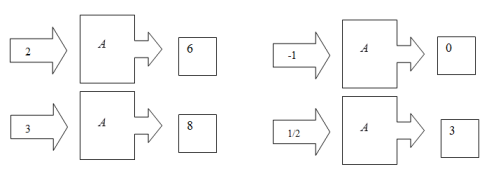
Which of the following equations could also represent A for the values shown?
\( \large A(n)=n+4\) Hint: For a question like this, you don't have to find the equation yourself, you can just try plugging the function machine inputs into the equation, and see if any values come out wrong. With this equation n= -1 would output 3, not 0 as the machine does. | |
\( \large A(n)=n+2\) Hint: For a question like this, you don't have to find the equation yourself, you can just try plugging the function machine inputs into the equation, and see if any values come out wrong. With this equation n= 2 would output 4, not 6 as the machine does. | |
\( \large A(n)=2n+2\) Hint: Simply plug in each of the four function machine input values, and see that the equation produces the correct output, e.g. A(2)=6, A(-1)=0, etc. | |
\( \large A(n)=2\left( n+2 \right)\) Hint: For a question like this, you don't have to find the equation yourself, you can just try plugging the function machine inputs into the equation, and see if any values come out wrong. With this equation n= 2 would output 8, not 6 as the machine does. |
Question 38 |
AHint: \(\frac{34}{135} \approx \frac{1}{4}\) and \( \frac{53}{86} \approx \frac {2}{3}\). \(\frac {1}{4}\) of \(\frac {2}{3}\) is small and closest to A. | |
BHint: Estimate with simpler fractions. | |
CHint: Estimate with simpler fractions. | |
DHint: Estimate with simpler fractions. |
Question 39 |
The column below consists of two cubes and a cylinder. The cylinder has diameter y, which is also the length of the sides of each cube. The total height of the column is 5y. Which of the formulas below gives the volume of the column?
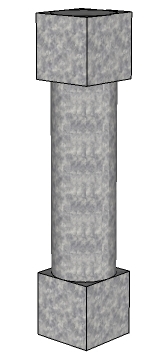
\( \large 2{{y}^{3}}+\dfrac{3\pi {{y}^{3}}}{4}\) Hint: The cubes each have volume \(y^3\). The cylinder has radius \(\dfrac{y}{2}\) and height \(3y\). The volume of a cylinder is \(\pi r^2 h=\pi ({\dfrac{y}{2}})^2(3y)=\dfrac{3\pi {{y}^{3}}}{4}\). Note that the volume of a cylinder is analogous to that of a prism -- area of the base times height. | |
\( \large 2{{y}^{3}}+3\pi {{y}^{3}}\) Hint: y is the diameter of the circle, not the radius. | |
\( \large {{y}^{3}}+5\pi {{y}^{3}}\) Hint: Don't forget to count both cubes. | |
\( \large 2{{y}^{3}}+\dfrac{3\pi {{y}^{3}}}{8}\) Hint: Make sure you know how to find the volume of a cylinder. |
Question 40 |
What is the mathematical name of the three-dimensional polyhedron depicted below?
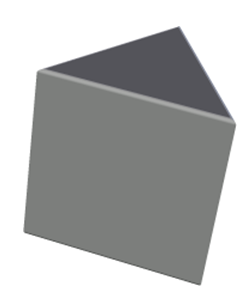
TetrahedronHint: All the faces of a tetrahedron are triangles. | |
Triangular PrismHint: A prism has two congruent, parallel bases, connected by parallelograms (since this is a right prism, the parallelograms are rectangles). | |
Triangular PyramidHint: A pyramid has one base, not two. | |
TrigonHint: A trigon is a triangle (this is not a common term). |
Question 41 |
A biology class requires a lab fee, which is a whole number of dollars, and the same amount for all students. On Monday the instructor collected $70 in fees, on Tuesday she collected $126, and on Wednesday she collected $266. What is the largest possible amount the fee could be?
$2Hint: A possible fee, but not the largest possible fee. Check the other choices to see which are factors of all three numbers. | |
$7Hint: A possible fee, but not the largest possible fee. Check the other choices to see which are factors of all three numbers. | |
$14Hint: This is the greatest common factor of 70, 126, and 266. | |
$70Hint: Not a factor of 126 or 266, so couldn't be correct. |
Question 42 |
A family went on a long car trip. Below is a graph of how far they had driven at each hour.
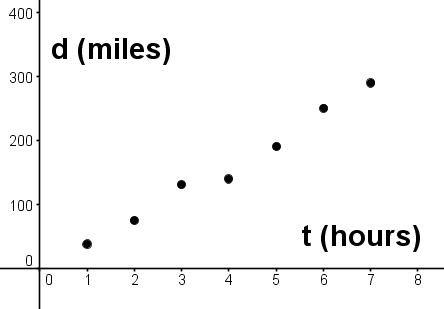
Which of the following is closest to their average speed driving on the trip?
\( \large d=20t\) Hint: Try plugging t=7 into the equation, and see how it matches the graph. | |
\( \large d=30t\) Hint: Try plugging t=7 into the equation, and see how it matches the graph. | |
\( \large d=40t\) | |
\( \large d=50t\) Hint: Try plugging t=7 into the equation, and see how it matches the graph. |
Question 43 |
\( \large \dfrac{17}{24}\) Hint: You might try adding segments so each quadrant is divided into 6 pieces with equal area -- there will be 24 regions, not all the same shape, but all the same area, with 17 of them shaded (for the top left quarter, you could also first change the diagonal line to a horizontal or vertical line that divides the square in two equal pieces and shade one) . | |
\( \large \dfrac{3}{4}\) Hint: Be sure you're taking into account the different sizes of the pieces. | |
\( \large \dfrac{2}{3}\) Hint: The bottom half of the picture is 2/3 shaded, and the top half is more than 2/3 shaded, so this answer is too small. | |
\( \large \dfrac{17}{6} \) Hint: This answer is bigger than 1, so doesn't make any sense. Be sure you are using the whole picture, not one quadrant, as the unit. |
Question 44 |
Each individual cube that makes up the rectangular solid depicted below has 6 inch sides. What is the surface area of the solid in square feet?
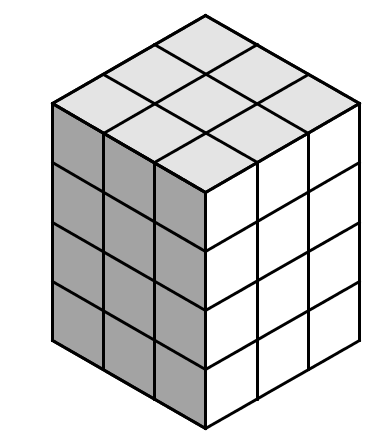
\( \large 11\text{ f}{{\text{t}}^{2}}\) Hint: Check your units and make sure you're using feet and inches consistently. | |
\( \large 16.5\text{ f}{{\text{t}}^{2}}\) Hint: Each square has surface area \(\dfrac{1}{2} \times \dfrac {1}{2}=\dfrac {1}{4}\) sq feet. There are 9 squares on the top and bottom, and 12 on each of 4 sides, for a total of 66 squares. 66 squares \(\times \dfrac {1}{4}\) sq feet/square =16.5 sq feet. | |
\( \large 66\text{ f}{{\text{t}}^{2}}\) Hint: The area of each square is not 1. | |
\( \large 2376\text{ f}{{\text{t}}^{2}}\) Hint: Read the question more carefully -- the answer is supposed to be in sq feet, not sq inches.
|
Question 45 |
P is a prime number that divides 240. Which of the following must be true?
P divides 30Hint: 2, 3, and 5 are the prime factors of 240, and all divide 30. | |
P divides 48Hint: P=5 doesn't work. | |
P divides 75Hint: P=2 doesn't work. | |
P divides 80Hint: P=3 doesn't work. |
|
List |
If you found a mistake or have comments on a particular question, please contact me (please copy and paste at least part of the question into the form, as the numbers change depending on how quizzes are displayed). General comments can be left here.
